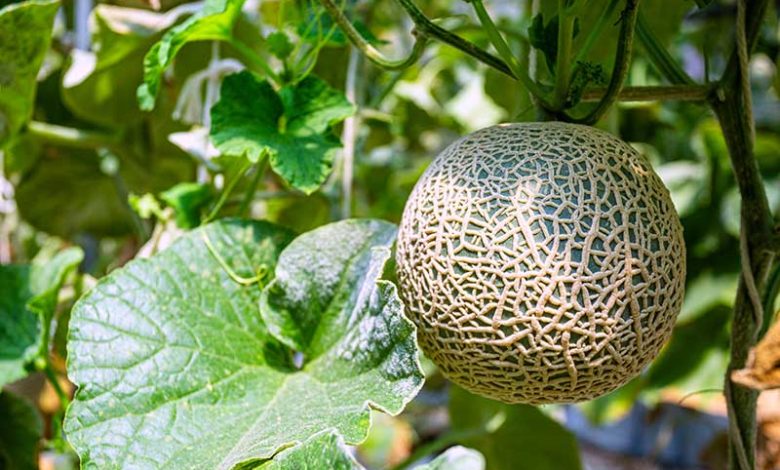
It is a significant vegetable crop in India. These are the mother fruits of many well-known cultivars. Moreover, muskmelon is indigenous to Iran, Anatolia, and Armenia. Musk melon is high in vitamin A and vitamin C. It is composed of approximately 90% water and 9% carbohydrates. Punjab, Tamil Nadu, Uttar Pradesh, Maharashtra, and Andhra Pradesh are among the Indian states that grow muskmelon.
Muskmelon Farming Tips and Methods
Read the following tips carefully to perform a high yielding muskmelon farming.
Climate Requirement
The temperature for muskmelon farming must be 18-30°C. And the rainfall from 50 – 75mm is suitable for muskmelon farming. Lastly, take care that the temperature must be 25-30°C during harvesting.
Soil Requirements
It thrives in deep, fertile, well-drained soil. It performs best when grown in well-drained loam soil. Muskmelon cultivation is not suitable for soil with poor drainage capacity. Crop rotation is important because growing the same crop on the same field for an extended period causes nutrient loss, poor yield, and increased disease attacks. The perfect pH range of the soil should be between 6 and 7. A high salt concentration in alkaline soil makes it unsuitable for cultivation. Moreover, you should use excellent agricultural equipment like Swaraj 963 and others.
Popular Varieties
Hara Madhu: This is a late-maturing variety. Fruits are large and round, with an average weight of about one kilogramme. The skin is a pale yellow colour. TSS content is approximately 13% and very sweet in the test. The flesh is green in colour, thick, and juicy, and the seeds are tiny. Therefore, powdery mildew is not a problem for it. Moreover, it produces an average yield of 50qtl/acre.
Punjab Sunehri: It matures 12 days before Hara Madhu. The fruits are round, with a netted rind and a light brown. It has an average weight of 700-800gm and a TSS of about 11%. The flesh is thick and orange in colour. It has a good preserving quality. Moreover, it is resistant to being successfully attacked. It has an average yield of 65qtl/acre.
Punjab Hybrid is a variety that matures early. The fruit is round, light yellow in colour, and has netted skin. The flesh is thick, orange in colour, juicy, and has an excellent flavour. Moreover, TSS can reach up to 12%, with an average weight of 800gm. It is resistant to fruit flies and produces an average yield of 65 quarts per acre.
MH-51: In 2017, it was released. It produces an average yield of 89 quarts per acre. It has round fruits that are striped and gauzed. In addition, it has a sucrose content of 12 per cent.
MH-27: In 2015, it was released. It yields an average of 88qtl/acre. It has a sucrose content of 12.5 per cent.
Soil Preparation
Plough the ground and bring it to a fine tilth. Sowing takes place in North India in the middle of February. Moreover, Sowing takes place in North East and West India from November to January. Prepare the soil with good quality farming equipment like Swaraj 735 and others.
Sowing
The middle of February is the best time to plant muskmelon. Prepare 3-4m wide beds depending on the type of use. Sow two seeds per hill on the bed, keeping a 60cm distance between hills. And sow the seed 1.5cm deep. We can use sowing methods such as dibbling and transplanting.
Transplanting
From the last week of January to the first week of February, sow seeds in a 15cm x 12cm polythene bag with a thickness of 100 gauge. Fill a polythene bag halfway with well-rotten cow dung and soil. By the first week of March, seedlings are ready for transplantation. Transplantation is performed on seedlings that are 25-30 days old. Irrigate immediately after transplanting.
Weed Control
During the early stages of growth, keep the bed weed-free. Weed can cause a 30% yield loss in the absence of proper control measures. Therefore, we should carry out intercultural operations 15-20 days after sowing. Two to three weedings are required depending on the severity and intensity of the weeds.
Irrigation
In the summer, apply irrigation once a week. Irrigate only when necessary during the maturation period. Avoid flooding in the muskmelon field. Irrigation should not wet the vines or vegetative parts, especially during flowering and fruit-set. Irrigation should be avoided on a regular basis in heavy soil because it promotes excessive vegetative growth. Stop or reduce watering 3-6 days before harvesting for improved sweetness and flavour.
Harvesting
Haramadhu should be harvested when the fruits turn yellow. Then, depending on the market distance, harvest another variety. Fruits for long-distance markets should be harvested at the mature green stage, while we should harvest fruits for local markets at the half-slip stage. The half-slip stage is indicated by a slight depression of the stem end. Also, you can use a powerful tractor like Swaraj 744 for increasing productivity and farm output.
Post Harvesting
Precool the field after harvesting to reduce field heat. The size of the fruit is used to grade it. Muskmelons harvested in partial slip can be stored for up to 15 days at 2° to 5°C and 95% relative humidity, whereas Muskmelons harvested in full slip can be stored for 5 to 14 days at 0° to 2.2°C and 95% relative humidity.
For more, stay with us.



